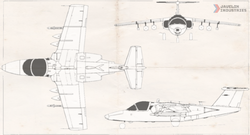T-5/A-5 Tejón de Miel

| |
| Type: | Jet trainer / close air support |
| Designer: | Javelin Industries |
| Manufacturer: | Javelin Industries |
| Development: | 1686 AN – 1691 AN |
| In service: | 1692 AN (anticipated) |
| Operators: | |
| Crew: | Two |
| Length: | 10.8 m |
| Wingspan: | 9.5 m |
| Height: | 2.7 m |
| Empty weight: | 2,849 kg |
| Take-off weight: | 4,635 kg |
| Powerplant: | 2x Javelin Industries J89 Turbojet, 2,850 lbf of dry thrust each |
| Maximum speed: | 970 km/h |
| Range: | 2,300 km |
| Service ceiling: | 13,700 m |
| Armament: | 6 hardpoints (RP standard: AAMs, ASMs, gun pods, bombs, rockets) |
| Unit cost: | |
| Status: | Development / Initial Production |
The T-5/A-5 Tejón de Miel is an Alduro-Wechuan high-wing, twin-turbojet, ground-attack aircraft developed by Javelin Industries in response to the Department of Defense's Operational Requirement 1685.102 for a twin-engine jet aircraft to complement the turboprop T-4/A-4 Flecha in the close air support and limited air defence role.
Development
Conceived and financed under the defence "pillar" of the New Prosperity Plan, the Operational Requirement specified that 100% of the design, 75% of the materials (including composites), 50% of the components (including engine components), and 25% of the avionics, were to be sourced from Alduro-Wechuan industries with final assembly to take place in Alduro-Wechuan territory. Additionally the Operational Requirement mandated compatibility with Raspur Pact standard communications systems and ordnance loadouts. Following the review of expressions of interest received from the country's defence manufacturers, the decision was made by the Aerospace Directorate of the Department Defense to accept the tendered design proposal received from Javelin Industries on 18.XIV.1685 AN. The contract awarded gave Javelin Industries five years in which to deliver a working prototype for evaluation testing and a subsequent ten year period, upon acceptance, in which to fulfil a subsequent order for the manufacture of 1,568 airframes of the type.
The performance specifications of Operational Requirement drove the development of the Javelin Industries J89 Turbojet, upon which work began on 12.I.1686 AN after proposals for the licenced production of the Constancian axial turbojet engine utilised in the T-3 Akóntio were rejected on account of the reputation for mechanical unreliability in the design that dated back to the War of the Harpy.
Design
Operational history
Orders
 Federal Forces of Nouvelle Alexandrie – 1,528 (1685 AN, due by 1696 AN)
Federal Forces of Nouvelle Alexandrie – 1,528 (1685 AN, due by 1696 AN) Imperial Constancian Air Force – 100, with initial option for additional 100 (1685 AN, due by 1696-1697 AN)
Imperial Constancian Air Force – 100, with initial option for additional 100 (1685 AN, due by 1696-1697 AN) Sanaman Air Force – 105 (1691 AN)
Sanaman Air Force – 105 (1691 AN) Sanaman Navy – 8 (1694 AN) Evaluation for possible carrier-based close air support role
Sanaman Navy – 8 (1694 AN) Evaluation for possible carrier-based close air support role Union Defence Force – 40 (1695 AN)
Union Defence Force – 40 (1695 AN)